Psoriasis
Dr Mike Wyndhamis a GP in a suburban practice in Edgware Middlesex.
Dr Mike Wyndhamis a GP in a suburban practice in Edgware Middlesex.
He has always been a keen photographer, and has been taking medical photographs for more than 25 years. He has been a regular contributor to the GP press and his work has also appeared in the British Medical Journal, The Pharmaceutical Journal and various medical text books
Psoriasis is an autoimmune condition, in which the normal regeneration of skin cells is greatly speeded up, resulting in an accumulation of skin cells on the surface of skin. In psoriatic arthritis, the joints - rather than the skin surface - are affected; 10-30% of psoriasis patients will also have psoriatic arthritis. Severity varies greatly between individuals: in some people it is no more than a minor irritation, but for others it can have a major impact on quality of life. Symptom severity can also vary, with periods of remission and disease activity. There is no cure, and management can be challenging but there is a range of treatments that can improve symptoms
Guttate Psoriasis
Guttate psoriasis affects young people including children. It is precipitated by a streptococcal throat infection and the rash will usually develop 2-3 weeks after the infection. The word guttate is derived from the Latin word gutta meaning 'drop'. The skin lesions are small, up to a size of a centimetre and may be covered in scale. However, this picture shows that this may not be visible. Gently stroking the surface caused the scale to appear. The rash generally affects the trunk and limbs and will usually resolve on its own over the following few months. However, where the patient wants to clear the rash more quickly, topical applications may be time consuming and a small amount of ultraviolet light 'will do the trick.'
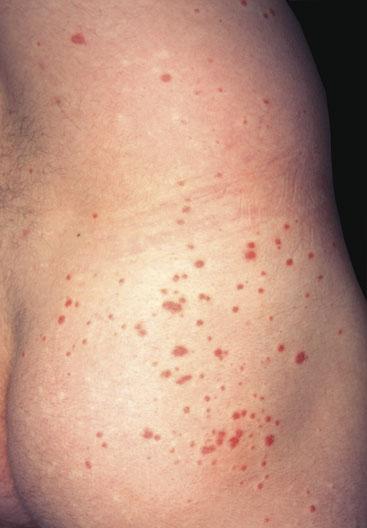
Psoriasis nails
Nail changes in psoriasis include onycholysis, pitting and hyperkeratosis. Onycholysis describes the lifting of the nail away from the nail bed. This condition is not just confined to psoriasis where the bed nearby becomes discoloured but may occur with fungal infection, application of acrylic nails, or tetracycline therapy. Pitting has a strong association with the development of arthropathy. However, it is not unique to psoriasis and may occur when eczema occurs around the nail bed and in alopecia areata. Occasional nail pits may be seen in normal individuals. Development of keratin under the nail (subungual hyperkratosis) usually affects the toenails.
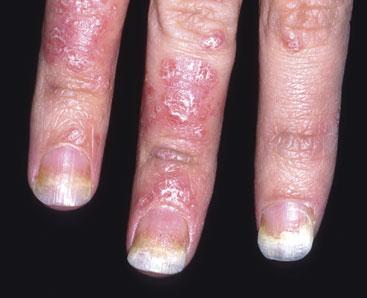
Psoriatic arthropathy
Arthropathy occurs in around 20% of psoriasis sufferers. There are varying presentations: asymmetrical with less than 5 joints involved; symmetrical affecting hands, wrists, and feet; affecting the distal interphalangeal joints of hands and feet; back stiffness in the morning caused by sponydylitis which may be accompanied by sacro-iliitis; and arthritis mutilans where joints of the hands and feet become deformed. Pain may be treated with non-steroidal anti-inflammatory agents. Where this is ineffective, methotrexate may be used with a weekly dosage. It is important that the patient has a shared-care programme/booklet to ensure good communication between primary and secondary care. Alternative therapies include the cytokine modulators, etanercept or adalimumab.
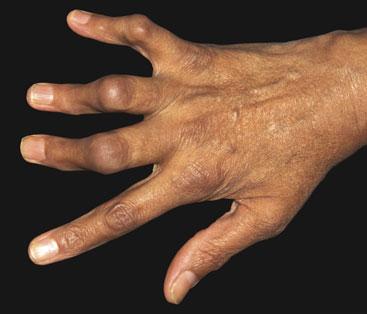
Plaque Psoriasis
Psoriasis affects around 2% population in the United Kingdom and men and women are affected equally. There is a strong genetic association with 35% of sufferers having a family history. The lesions are well demarcated and are usually covered in a silvery scale. The scale tends to be absent in places where there is dampness e.g. under the breasts, groins. The distribution of psoriasis is usually symmetrical affecting extensor surfaces. i.e. front of the knees and the back of the elbows which is the reverse of atopic eczema. Other areas commonly affected are: the scalp, natal cleft, umbilicus and nails.
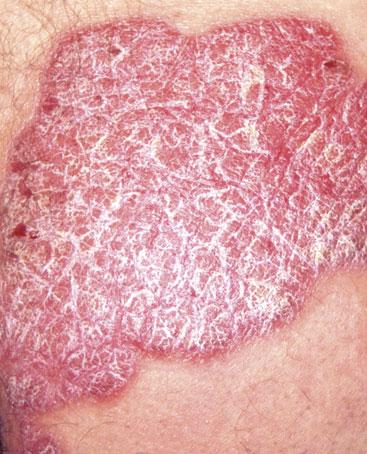
Erythroderma
Erythroderma is a term used to define where a skin condition affects more than 90% of the skin surface. It is not unique to psoriasis and may also be encountered in other conditions such as eczema, lymphoma and drug eruptions (penicillin, allopurinol). The condition is more common in men and usually older people. It usually develops rapidly and systemic symptoms include fever and feeling unwell. The skin becomes red while some areas may retain its scale. Complications may occur, such as infection, dehydration, hypothermia and heart failure. Treatment includes the removal of any precipitating factors such as oral steroids and treatment of the psoriasis with coal tar preparations
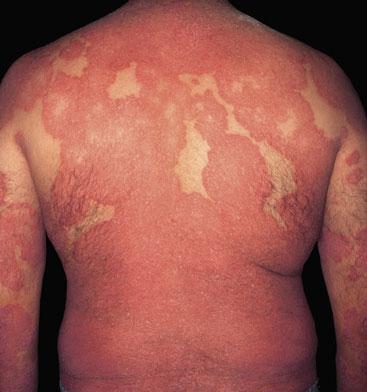
Palmopustular psoriasis
Palmopustular psoriasis is a localised form of psoriasis, which occurs more commonly in women who are usually of middle-age (over 50 years). The word pustule is misleading as it describes their appearance but their content is sterile. The development is strongly associated with smoking. The pustules appear in different stages. Betweeen 20-30% will have plaque psoriasis. The condition should be differentiated from pompholyx eczema, which occurs in young and early middle-age and is extremely itchy. In this condition, the lesions all look at a similar stage. Treating the condition can be difficult and so a potent steroid, such as betamethsone 0.1%, is recommended
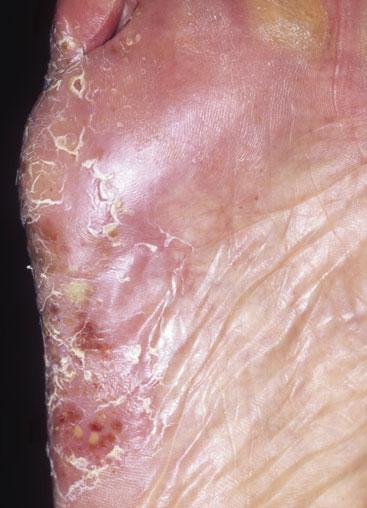
Related articles
View all Articles